Disclosure: Please note that some links are affiliate links, and at no additional cost to you, we earn a commission if you make a purchase.
If you would like to support this website in some way, using these links will help do exactly that.
The windows are wide open in the birthplace of Frankfurt am Main’s favorite son, Johann Wolfgang Goethe. A cool breeze shimmies its way in, stirring up historical smells. You only hear the sound of the wooden floorboards creaking under your feet and in neighboring rooms, and further away a student tour group is laughing. Ongoing construction site white noise from next door, the soon to be German Romantic Museum, foretells of historical fun to come in 2019.
Why Do You Need a Cheat Sheet to Visit?
There are very few descriptive signs hanging because the nonprofit group, which oversees the Goethe House and Museum, Freies Deutsches Hochstift wants to keep the presence of the house as authentic as possible. This means you need to either do some homework before visiting, succumb to an audio tour for 3 Euros extra, or, split the difference and get the beefier English brochure for 1.50 Euros and use that as your tour guide. Currently there’s only German tours on weekends, and no English tours at all.
My American education only mentioned Goethe in passing, and I imagine many others will relate. It seemed as though our English teachers had a hard enough time teaching us Canterbury’s Tales, Beowulf, and Shakespeare’s countless plays, they didn’t quite make it to Goethe’s oeuvre.
I’ve gathered together and simplified what you need to know in order to get the most out of your visit, but I do recommend buying the beefier English brochure. It is well produced and designed, as well as easy to pack and a great souvenir. The brochure goes room by room and discusses more highlights and goes into further detail.
Family is What Makes This House a Home
Johann Wolfgang Goethe and his sister Cornelia grew up in the top tier of Frankfurt’s society. They both received excellent, private educations. It was expected that Goethe would be a lawyer like his father before him. He went as far as finishing law school and opening a private practice when his literary career made him a celebrity.
Top 10 Historical Events You Need to Know About the Goethe House
1. Sold | Goethe’s grandmother on his father’s side (Cornelia Goethe), bought the property in 1733
2. Birth | Johann Wolfgang Goethe was born August 28, 1749
3. Birth | Goethe’s beloved sister Cornelia Goethe was born 1750
4. Renovation | Goethe’s father (Johann Caspar Goethe) renovated and combined two half-timbered houses into one spacious, Rococo-style home from 1755-1756.
5. French Occupation | Royal Lieutenant François Théas de Thoranc occupied the house from 1759 until 1761 during the French occupation of the Seven Years’ War, and had local artists visit to paint for him. As a result, Goethe watched Johann Georg Trautmann work on his Joseph Cycle paintings.
6. Writing | Goethe wrote “Goetz of Berlichingen” in 1773 and “The Sorrows of Young Werther” in 1774
7. Sold | Goethe’s mother sold the house, furniture, and her husband’s collections in 1795.
8. Sold | The house was acquired in 1863 by the Freies Deutsches Hochstift, “A Society Devoted to the Liberal Arts.” They began reassembling and recreating the home’s original furnishings.
9. Bombing | After the 1944 bombing raid, the house and Goethe Museum was completely destroyed. Furnishings and objects had previously been evacuated and were saved.
10. Rebuilt | Meticulous reconstruction from 1947-1951 led to the house and museum being reopened in 1954.
Must-See Highlights of the Goethe House By Floor
Ground Floor Highlights
1. Kitchen |The house still has it's original water pump linked to a well in the cellar, pure luxury in a time most households depended on a public well!
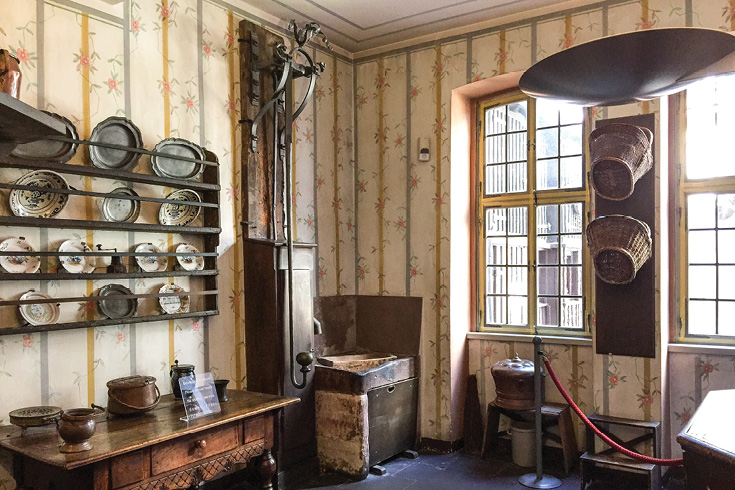
2. Staircase | The first four sandstone steps of the staircase on the ground floor are original, (survived the 1944 bombing.) The massive staircase and spacious landings were part of Goethe’s father’s renovation. Look for his parents’ initials in the ironwork of the railing on the first floor.
3. Blue Room | The framed oilcloth wallpaper hanging on the wall is from the house before the renovation, and allegedly acted as a tarp over the kids’ beds in the attic during the construction work.
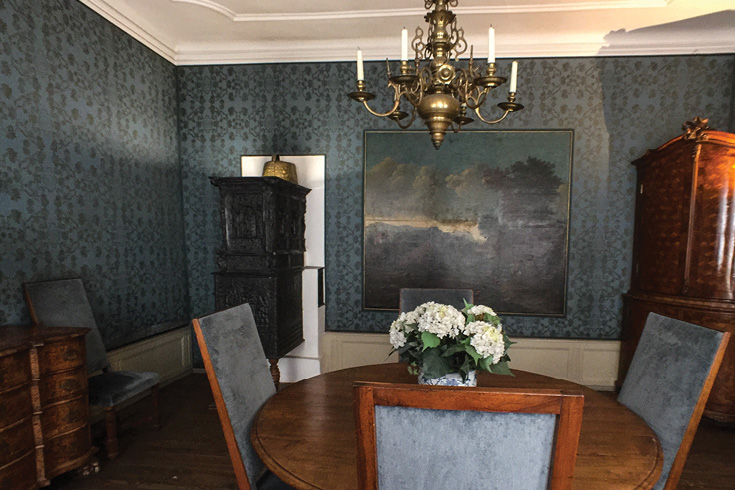
First Floor Highlights
1. Peking Room, also called Red Room | Behold the fabulous loud wallpapers with flowers and animals that imitate Chinese and East Asian styles!
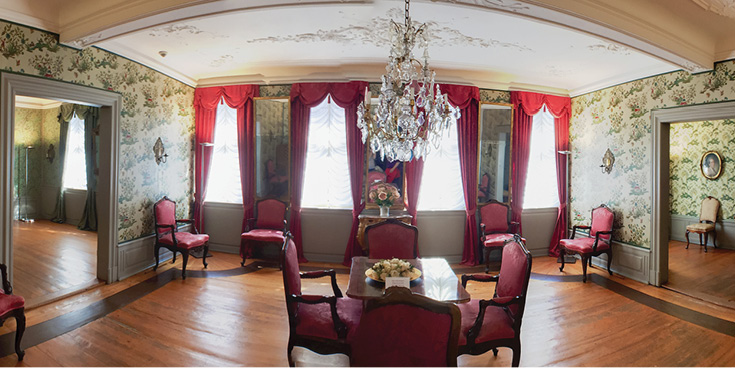
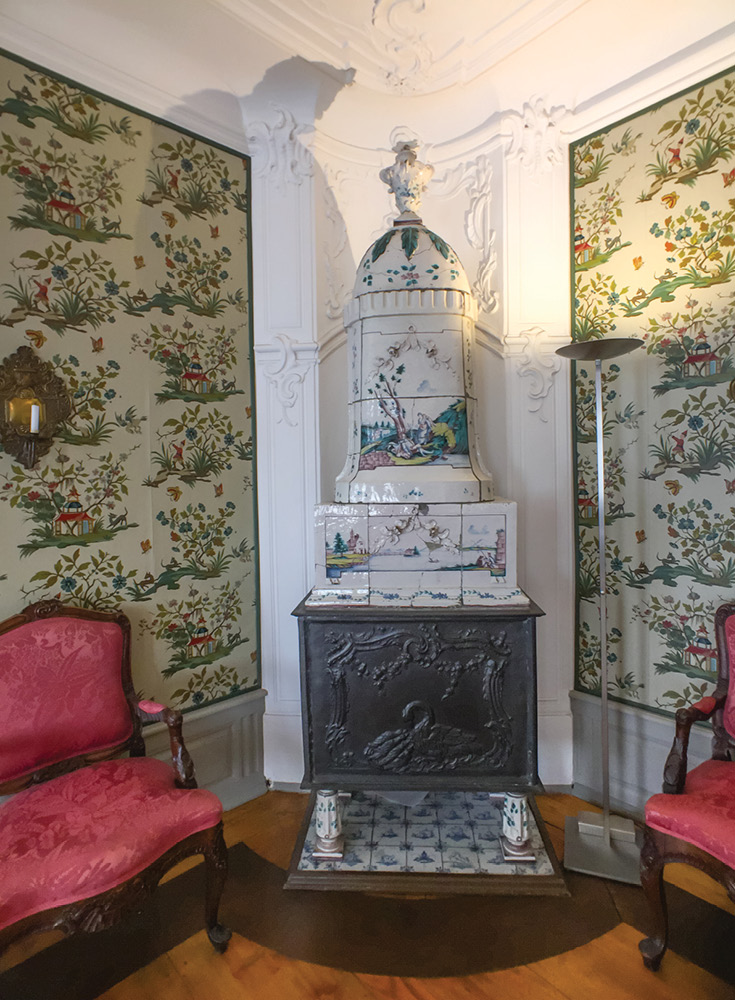
2. The Northern Wing Cabinet | There’s a portrait of the French Lieutenant Thoranc who occupied the first floor of the house from 1759 until 1761 during the French occupation of the Seven Years’ War.
3. Grey/Music Room | The Goethe family group of four was very close, and music was very important to them. Cornelia (sister) was excellent on the piano, the father played the lute, Goethe played the cello, and the mother sang. Above the red, upright pianoforte is a portrait of the Goethe family by Johann Conrad Seekatz. The five cherubs in the background symbolize the parents’ five other children who died very young.
Second Floor Highlights
1. Goethe’s Father’s Library | These books are scandalized by the idea of ebooks, and suspicious as to why they’re behind glass, lonely, and locked up!
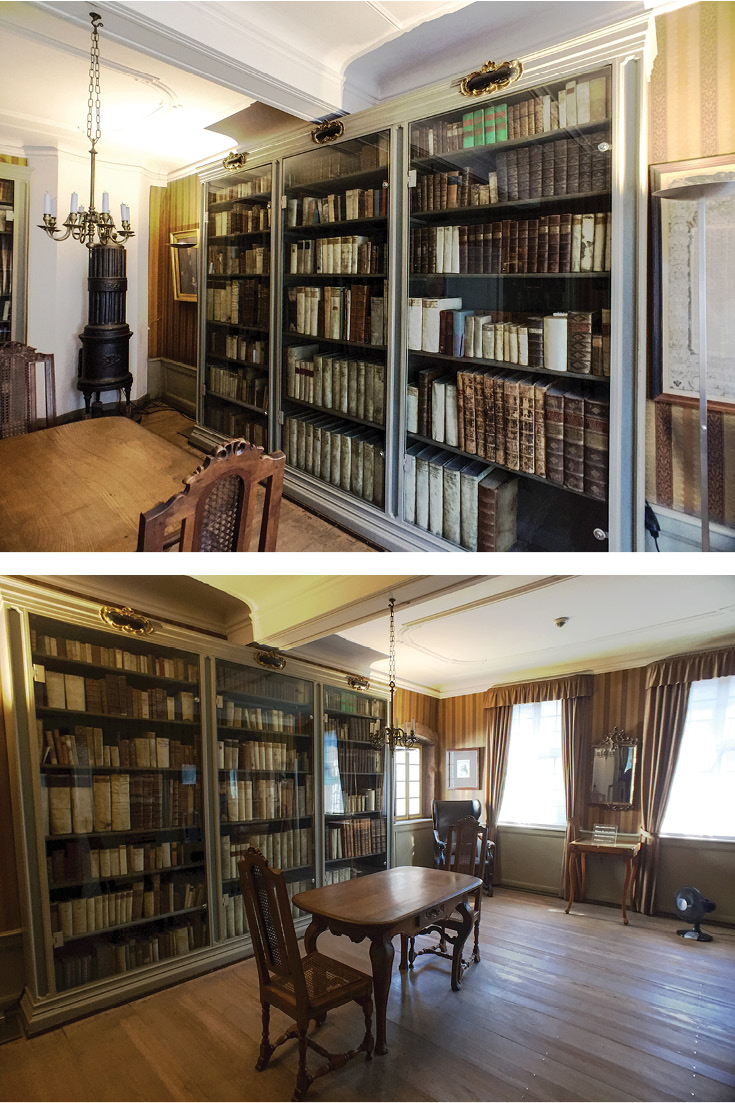
2. Cabinet of Paintings | Goethe loved art and especially the Dutch traditional style. He kept his art collecting local, and supported Frankfurt masters, Trautmann, Schütz the Elder, Juncker, Hirt, Nothnagel, and Morgenstern, as well as Darmstadt court painter, Seekatz.
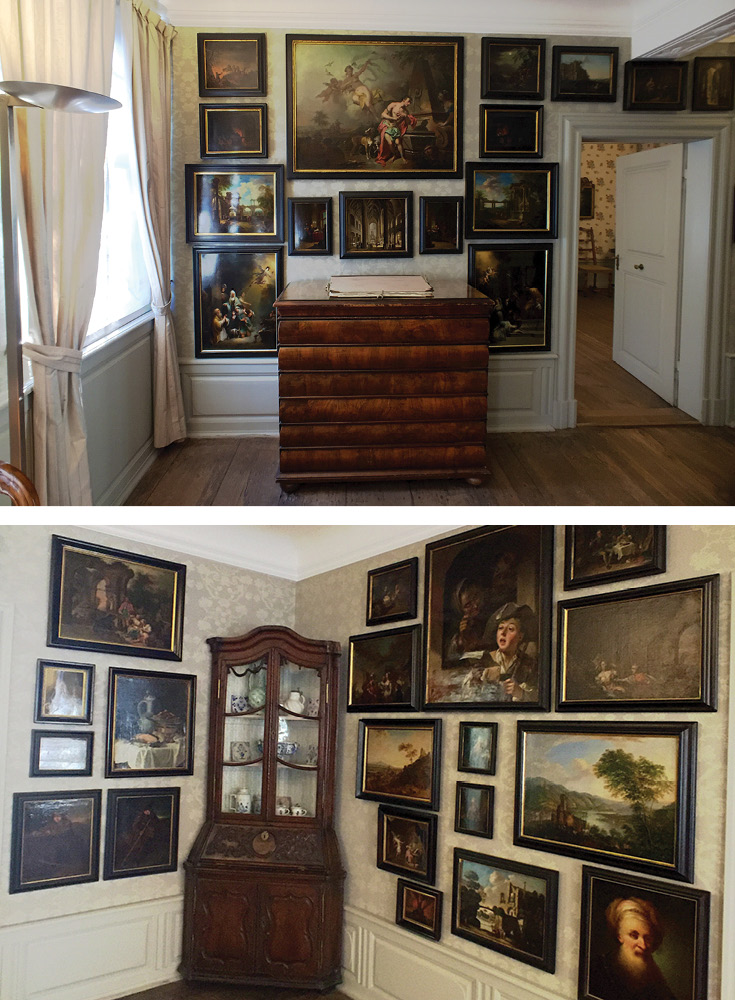
3. Astronomical Clock | Not original to the house, it was in Privy Council Wilhelm Friedrich Hüsgen’s home, where Goethe admired it when he was young. There is a dancing bear in the lower peephole that acts as a signal for winding up the clock. It was built in 1746.
Third Floor Highlights
1. Poet’s Room | Here, with it's original standing desk and a writing desk, is where Goethe wrote his early works.
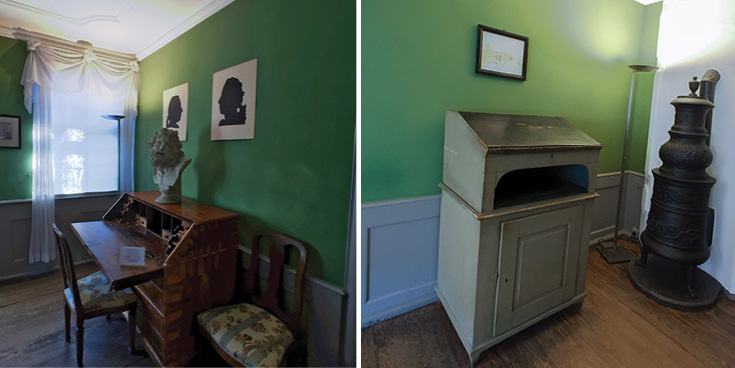
2. Puppet Theater | Goethe’s puppet theater he received when he was 4 years old, yes really! It’s survived. Worth climbing all those stairs? You bet.
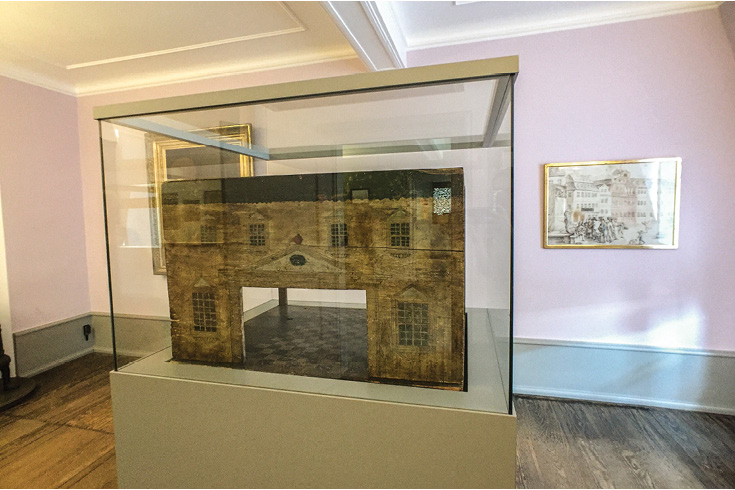
3. Western Attic Room | When the French Lieutenant Thoranc who occupied the house from 1759 until 1761 during the French occupation of the Seven Years’ War, he had many Frankfurt artists to visit and work in this room. Goethe watched Johann Georg Trautmann create his Joseph painting series in this room. They’ve since been returned from Thoranc’s estate to be displayed where they were created!
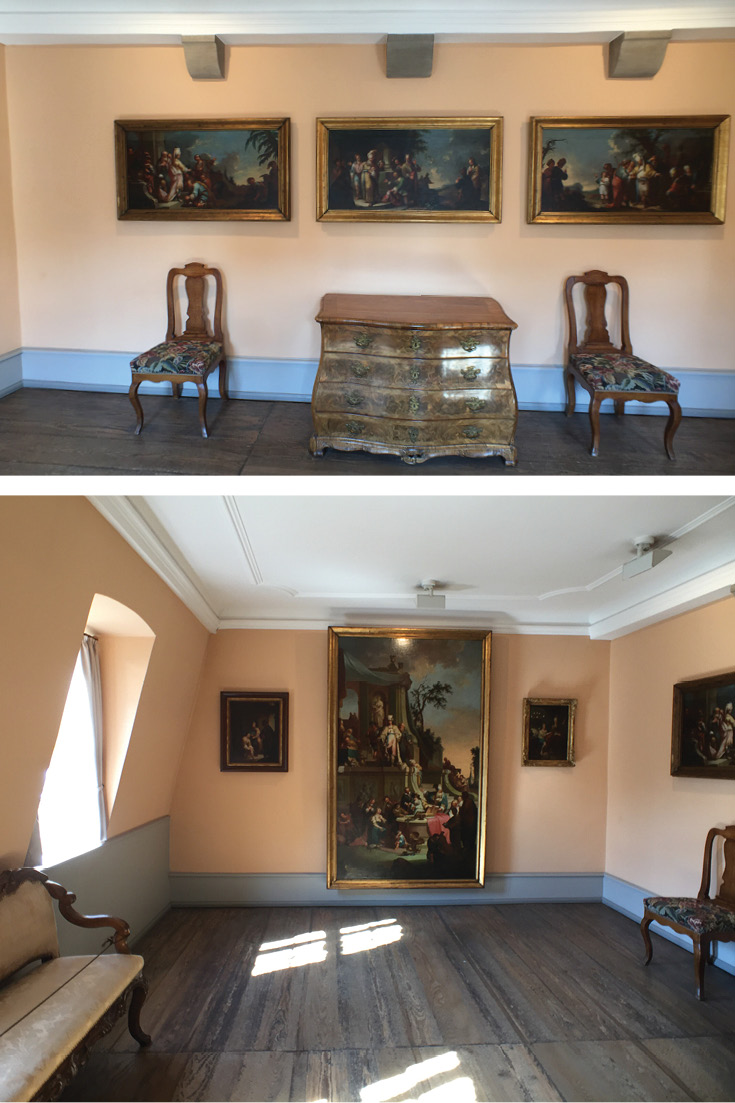
Follow Along
If you enjoyed this article, or these topics sound interesting to you, you'll love our weekly newsletter. You'll receive a free Germany Packing list for signing up, and you'll receive each week's newest posts every Friday. Thank you for reading!

The success story of ALDI started in the spring of 1913, when the baker Karl Albrecht, together with his wife Anna, opened “Albrecht” in Essen, Germany. At that time, self-service was still quite unusual and all customers were personally served by the store clerks. This is what the first storefront looked like:
After WWII, their sons Karl and Theo took over the store in 1945 and and expanded their family business into 100 branch stores by 1955 and over 300 by 1960. The ALDI brothers Karl and Theo are considered the inventors of the discount supermarket system in Germany and were among the richest people in the world, each valued at just under 20 billion dollars by Forbes magazine. However, both valued their privacy and declined most interviews, hence there are very few photos of the two brothers. Theo Albrecht died in 2010 due to a severe fall, and Karl passed away in 2014. Here is one of the few photos, from WirtschaftsWoche's archive:
A Disagreement About Cigarettes
The growth of the Albrecht store empire went well until 1960, when the brothers divided the company into two geographical areas in Germany: ALDI North and ALDI South. Apparently they had a clash of opinions regarding the sale of cigarettes. The northern branches were taken over by Theo, who was the one that wanted to sell cigarettes and and the southern branches were managed by Karl Albrecht (ALDI South sells cigarettes only since 2003).
Times are Changing
Also in the early 1960’s, Germans started to discover supermarkets how we know them today, where you can walk in, grab what you need, pay and leave. The small service stores like the ones from the Albrecht brothers saw a decline in sales and the brothers decided in 1961 to open their own chain of supermarkets. They chose the name ALDI (ALbrecht DIscount) for their new supermarket-style stores. Their concept for their new stores was a bit different than the one of a traditional supermarket. The ALDI stores offered no duplicates of food, so for example there was only one type of orange instead of several kinds to choose from. The basic idea is to only have products in the assortment which have a high turnover rate, about 700 items per store.
ALDI is focused on staple food items and did not issue price tags on each item until the early 1990s. I still remember being at ALDI with my mother and the cashiers would manually enter each price for each item with the prices they had memorized. If they were not sure, they would ask the next cashier over, who would then yell back with the exact price. The ALDI brothers also negotiated products with well-known manufacturers, which were produced under a different name specially for ALDI. As a result, these products were not subject to price constraints and advertising costs, enabling ALDI stores to sell them favorably.
ALDI Today
To this day ALDI stores are rather simple when it comes to decoration and advertisements. Most items are sold directly out of the manufacturers shipping carton and all shelves carry the same orange price sticker. All employees are cross-trained to be at the cash register or re-stock items that are running low. This omission of “traditional” supermarket retail features brought the ALDI supermarkets great cost advantages over the years, at the same time enabling consumers great price advantages. Until the 1980s, ALDI had the image of a “poor people's” supermarket. Their products were regarded as qualitatively sufficient, but without prestige. Even today, poor populations are an important target group for ALDI, however many of the products marketed by ALDI have very good test results in German Consumer Reports magazines.
An important image change for ALDI came during the 1990’s, when they started their short-term weekly offers, usually as part of a theme week, for example handyman items with an assortment power drills, saws and work boots. During my high school years and the rise of personal computers, ALDI even offered the first "ALDI PC" around Christmas 1995, right when the internet started taking off and everybody got an AOL CD in the mail every other week. It was a well-equipped machine, that sold out in the first hours of the sale, based on its fair price and the fact that the German computer market was unsaturated with computers. This is a picture of the first PC’s being sold by ALDI, photo courtesy of Lebensmittel Zeitung:
2 Tips When Shopping at ALDI
Two things to keep in mind before you visit ALDI for your first time either in Germany or in the States: Customers are expected to bring their own bags from home to transport their groceries, otherwise they can purchase bags at the store for a small fee. That way ALDI cuts down on the use of plastic bags, which is good for the environment and good for their expenses.
Secondly, expect to pay a deposit if you want to use a shopping cart. Another way ALDI saves, is that customers pay a 1 Euro deposit to use a shopping cart at ALDI. "The shopping cart rental system is one of many ALDI efficiencies that enable us to keep our prices so low," the company informs on its website. "By not having to hire someone to police the shopping carts, we are able to pass the savings onto our customers." In the USA the deposit is typically a quarter.
You can see their current sales ad here.
Have you been to an ALDI store already? What do you think about them? Let us know in the comments.
Follow Along
If you enjoyed this article, or these topics sound interesting to you, you'll love our weekly newsletter. You'll receive a free Germany Packing list for signing up, and you'll receive each week's newest posts every Friday. Thank you for reading!


The plane jostles and shakes, as if we’re riding a bucking bronco in a rodeo. The overhead, ever-so-polite DING sounds to indicate the fasten our seat belts icon has illuminated again. Barely a moment passes before the airplane’s intercom crackles to life, suspending all of the in-flight movies. First in German, and then in English, we’re informed of turbulence. Yup. Kind of hoping that’s all it is. Sebastian squeezes my hand, and I squeeze his back. I take a deep breath. It's time to break out one of my tools for mentally getting through the heart stopping moments of turbulence when my imagination wants to concentrate on every single horrible, tragic ending to my situation.
1. Mental Images: Good Imagination For Peace of Mind
A therapist from college taught me how, and it's the closest I’ve ever felt to being a jedi. First you imagine white light. Starting from inside you, you envision the light, and concentrate on expanding it, pushing it out as if you’re in a bubble of white light. Personally, I take this a step further and imagine a polar bear, my favorite animal, something that brings me peace and a spark of joy. For you, it's probably a different animal, or a person, or a good memory, or a place. Famously, in my favorite movie French Kiss, Meg Ryan’s character Kate has a little cottage she’s supposed to imagine. Or if you’re a Harry Potter fan, think of the Expecto Patronum spell, what’s your Patronus?
2. Bottle Up Your Happy Place
When you start to panic during turbulence, break out your good smells. If you have a calming essential oil you like, a book that’s sporting the new book smell, or a sweatshirt that smells like home, get it out, close your eyes, and breathe it in. Let your nose fool you into believing you’re anywhere else but on a plane.
Smell is our only sense that projects directly
to the amygdala, a center connected with emotion and memory. Using smells during emotionally heightened episodes, like turbulence on a plane, can retrieve pleasant memories more powerfully than other senses.
3. Tick Tock, Tick Tock
Hyperventilating? Being told to take a deep breath isn’t very helpful is it? Something that helps me find my rhythm is a ticking clock. Look into downloading a sound or nature app on your phone. Most of them have an old fashioned clock and more. I’ve seen one that has a cat purring sound. Anything that is regular and a soothing sound can help regulating your breaths or heart rate. Yes, the next time the plane lurches suddenly you'll have to start over again, but it gets easier.
4. Give Yourself Something to Look Forward To
Notoriously, the flight back from German to the U.S. is worse as far as turbulence goes, with the plane fighting against the wind and jet streams the whole time. Once, personally I experienced turbulence over the Atlantic that dragged on for hours. You may need a long-term plan. Save the next few episodes of a TV show you’re currently loving to binge watch during the turbulence. Similarly, get hooked on a new book a few days before your departure date so you can’t wait to jump back in again. Don’t buy a new book that you may or may not get into, take one whose world you’re already distracted and enthralled with.
What has gotten you through seemingly never-ending turbulence?
Follow Along
If you enjoyed this article, or these topics sound interesting to you, you'll love our weekly newsletter. You'll receive a free Germany Packing list for signing up, and you'll receive each week's newest posts every Friday. Thank you for reading!

